One Globe Forum 2020
- New dates
coming soon! - Register

Inaugural Keynote Address by Shri Salman Khurshid, Minister for External Affairs
• Inaugural Keynote Address by Shri Salman Khurshid, Minister for External Affairs
Until recently, information and the access to information existed primarily through publications and obscure journals; to be considered an expert in a chosen field one had to be extensively trained and fine-tune their ability to search for and create new information. With the advent of technology, the access to information has become accessible to everyone, which begs the question of how the knowledgeable person is defined in today’s society. There currently exists a struggle in India between those who are supremely knowledgeable and believe their word is ultimate based on their positions as thought-leaders, and those who wish to push the envelope and envision a brighter future for India in the 21st connectivity between people and knowledge hubs to be able to harness the creation and sharing of knowledge and ideas. India’s huge potential in establishing itself as a knowledge centre can be seen through the country’s mission to Mars and the computer networks, human resources, and cutting edge technology that higher education institutions like the International Business School and India Institute of Technologies have delivered. India’s real challenge is the apathy and unwillingness that exists to open its own mind – a country that is committed to the principles of Century. It’s imperative that India provide the Mahatma Gandhi cannot now shut itself off to knowledge.
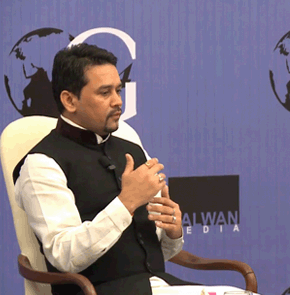
A Conversation on Harnessing India’s Demographic Dividend
• Shri Anurag Thakur, MP and President BJYM
• Harjiv Singh, Salwan Media
With 71% of India’s population below the age of 35, India’s youth population is large and restless, with big dreams that are more liberal, market-oriented and globally relevant than their parents. To help India’s youth achieve its goals, the country requires “new politics” that are transparent and accountable. These new politics will need to understand what the education, employment and empowerment needs of the next generation are. Currently, education spending is a state level activity with some states investing as much as US$ 627 per student and other states spending as little as $100. To have an educated society that is knowledge-based, India also needs to establish more vocational training and higher education institutions. The Indian government needs to increase and have parity in its education budget, as well as partner with private players to incentivize large-scale innovations in education delivery. Formal sector employment in India is at an abysmal state with almost 93% of the country’s population engaged in the unorganized sector. With 1,000,000 youth entering the labour market every month, India needs bold solutions to create a labour-oriented job market and a skilled workforce. At the same time, any law is only as good or bad as its country. India needs better law and order, faster decision- making and transparency in its systems at the policy level.
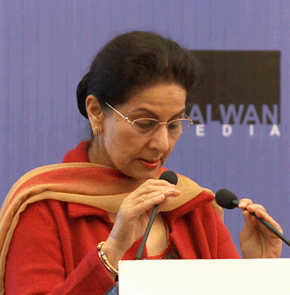
Address by Smt. Preneet Kaur, Minister of State for External Affairs
• Address by Smt. Preneet Kaur, Minister of State for External Affairs
Amartya Sen once said, “You need an educated, healthy workforce to sustain economic development.” Education improves the quality of life of individuals and society by increasing employment opportunities, raising income levels and encouraging people to make healthier choices. With the passing of the Right to Education Act in 2009 and the implementation of the Sarva Shiksha Abhiyan, ensuring free and compulsory education to children ages 6 - 14, the Government of India has proven its commitment to education – to date, almost 200 million children have been educated through improvements in school infrastructure and teacher training. As a result, India has seen decreased dropout rates in Classes 1 – 10, as well as higher enrolment and attendance rates. However, with 54% of India’s population under the age of 25, industry and civil society need to aid the government in ensuring equal, quality education for all regardless of age, gender, or disability. Education to empower women is of critical importance. Denying the opportunity for women to realize their potential is a waste of human capital and bars economic progress. The answers for India’s economic growth lie with education.
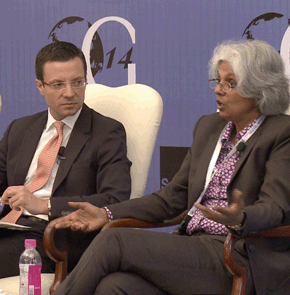
Does Education Drive Economic Growth
• Onno Ruhl, World Bank
• Dr. Shailaja Fennell, University of Cambridge
• Zeb Eckert (Moderator), Bloomberg Television
GDP growth requires investment. The success stories of China and South Korea are prime examples of how investing in education can drive the economy; increased education levels allowed more people to enter the labour force, fuelling a significant rise in GDP growth in both countries. The challenges India faces today towards education revolve around the issues of quality, higher education, employability and gender. The Sarva Shiksha Abhiyan has increased primary school attendance rates to 90%, but investments in teacher training and innovative education delivery models at the primary and secondary school level are needed to increase quality and achieve age-appropriate learning levels. India needs to establish 400 higher education institutions to meet the demands of the nation’s economy, and to position itself as a knowledge economy. At the same time, vocational skills will drive economic growth and India can benefit from re-inventing itself as a manufacturing powerhouse, skilling millions of youth along the way and incentivizing formal sector employment to address youth aspirations. Inclusive education will also be important to drive inclusive growth, and particular attention needs to be paid to the schooling and skilling of women, who also need to be encouraged to enter the workforce. In order to the do this, the government should increase it’s spending from 4% to at least 7% and encourage public – private partnerships to stimulate India’s education ecosystem and drive growth.
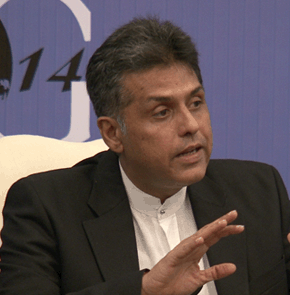
Valedictory Keynote Address by Shri Manish Tewari, Minister of Information and Broadcasting
• Valedictory Keynote Address by Shri Manish Tewari, Minister of Information and Broadcasting
The past two decades has seen a fundamental change in the information architecture of the world – the internet has changed the way we consume, disseminate and create knowledge, and broken the physical barriers that once existed in uniting knowledge communities. But with the ease at which information flows today, the world is also presented with several challenges to ensure the information age remains free from rules of engagement and committed to the freedom of speech. With the rise of firewalls and nations like China creating virtual barriers for information, privileged countries must ensure the equal distribution of knowledge. There also exists a new spectre of information overload for younger generations, where too much information is being accessed but not fully understood, analysed or processed. India in particular needs to introspect on the usefulness and quality of information that is disseminated, and media needs to be more responsible with it. In order for India to thrive, the country also needs to understand how young people can utilize knowledge to make them productive and how the access to information can be more widely available for this purpose.
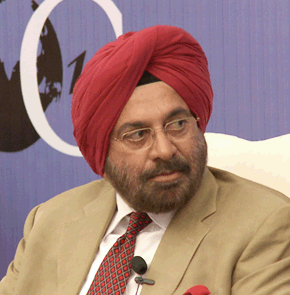
What Role can Education Play to Solve National Security Challenges? A Conversation on South Asia’s Perspective
• General J.J. Singh, Governor of Arunachal Pradesh
• Dalbir Singh, All India Congress Committee
Historically, national security in India has centred on creating a strong, military force that would secure the country’s physical boundaries and maintain peace among diverse ethnic groups. But, modern day security issues include securing the countries environment, food chain, education system, water supply, and technological infrastructure among many other facets. Education can help address these security concerns in several ways. At the most basic level, the public needs to be better educated and further engaged with the armed forces – schools need to address issues of diversity, geography and conflict in the classroom and military personal can address them. India should also attempt to stabilize insurgency in conflict regions in the Northeast, Jammu and Kashmir, and other regions by providing access to quality, free education and by acknowledging diverse heritage in our curricula. Indian higher education institutions and private corporations can also play a significant role by strengthening the technological infrastructure needed to help address India’s national security challenges.
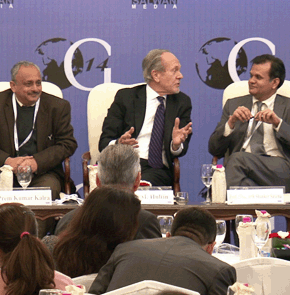
Can Higher Education Transform India into a 21st Century Knowledge Hub?
• Siddarth Saxena, Cambridge Kazakhstan Centre
• Dr. Prem Kalra, Dayalbagh Educational Institute
• Vineet Kshirsagar, Oracle
• Jerry MacArthur Hultin (Moderator), New York University
Higher Education has the potential to transform India into a 21st hub, but first, the country must address the purpose of higher education and how India wants to see itself in the knowledge value-chain. At the same time, India is uniquely challenged when it comes to scale – 300 million young people require an education and if they aren’t absorbed into the educational system, there is no potential for India’s progress. To become a knowledge hub, India needs a new, multi-pronged education model that develops large-scale vocational training as well as the pure sciences and humanities fields, while simultaneously championing women’s empowerment and support mechanisms to fund higher education for those who cannot afford it. Regulations within the Foreign Education Bill also need to be loosened so that international partnerships at the institutional level can be forged. At the same time, technology will be key in increasing the efficiency of dispensing education and the quality of teaching, and must be leveraged to created linkages between cities, schools and teachers both nationally and internationally. With these solutions, India will have the ability to increase quality education, foster collaboration and convert information into knowledge.
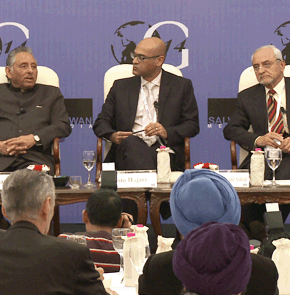
Can South Asia Overcome Political Differences to Collaborate on Education?
• Shri Mani Shankar Aiyar, MP Congress
• Ambassador (R) Sajjad Ashraf, Former High Commissioner of Pakistan to Singapore
• Nisid Hajari (Moderator), Bloomberg View (Asia)
Sixty-six years post partition, India and Pakistan should be ready to foster collaboration in order to grow South Asia’s presence in the global economy – imagine the powerhouse that the region could become if it unites. The many shared cultures that exist between the two countries are what bring South Asian communities together outside the region, particularly within North American and European universities, where political discourse can be debated freely. These shared cultures need to be explored more closely among Pakistanis and Indians not only at the national level, but by creating bonds region-to-region. At the same time, while Pakistan has evolved to establish its own identity, India needs to put the past behind and forge a new understanding of the region within the cultural and political framework of the 21st countries committed to university cooperation between researchers, academics and students as a first step in diplomacy through higher education. While many of these first initiatives are slowly flailing, India and Pakistan can also benefit from private university cooperation, and work with international institutions to create regionally collaborative educational platforms. Century. In 2012, the governments of both.
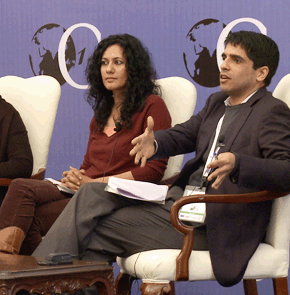
Advancing Pre-School Education in India
• Chhavi Rajawant, Sarpanch - Village Soda, Rajasthan
• Amol Arora, Shemrock & Shemford Group of Schools
• Anshul Arora, Edvance Pre-School
While often underrepresented in education platforms, pre-school education is slowly being recognized as extremely important in the overall development of the child. Research suggests that the most crucial period in a person’s life for brain development is from pre-birth to the age of 6, and the gains in educating children at this age have pointed to increased achievement test scores, high school matriculation and college enrolment rates. In the 21st should not be narrowly viewed as just a primer to primary school admissions but should cater to the curiosity and creativity of children below the age of five, developing confidence, concept clarity, vocabulary and independence through activity and entrepreneurial based activities. In India, many of these benefits have been acknowledge in urban areas, but there still exists the issue of quality and scale – 157 million children are below the age of five in India, 70% in rural areas who while are willing to pay cannot afford the same premium. Private players have Century, pre-school education made a dent in urban markets, but the government needs to help leverage its funding towards young children by encouraging public-private partnerships for pre- school education. Only then will pre-school providers see the potential return on investment by setting up schools in smaller cities and rural areas around the country.
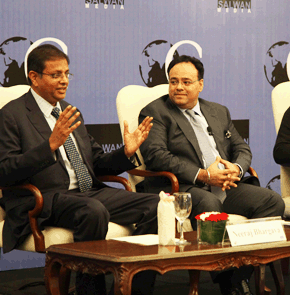
Investing in 21st Century Skills: An Investor’s Perspective
• Neeraj Bhargava, Zodius Capital Advisors
• Gurjit Singh Lalli, Asia Scotland Institute
• Harjiv Singh (Moderator), Salwan Media
The Indian education system caters to 600 million people, with public funding in education at 3.5% of GDP and private sector investment at US$ 40 billion per year. The education industry is growing at an annual rate of 15% per year, largely due to an influx of investments such as private equity, venture capital and angel investment. While traditional education sector investments, like curriculum and skills development, are diminishing, investors are asking themselves what emerging skills are necessary for 21st are providing these skills. These include initiatives in the performing arts, through MOOCs, entrepreneurship-focused platforms, child-centric education models, online testing services and technological interventions that disseminate content more effectively. With enterprises thinking more outside of the box and focusing on cultivating 21st investors are seeing their potential return on investment in the long-run. Century jobs, and are looking for innovative start-ups that Century skills such as creativity and an entrepreneurship spirit,
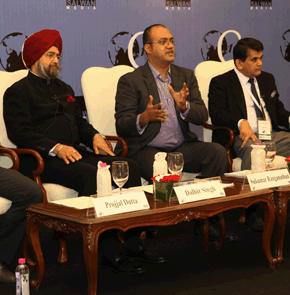
Smart Cities and Economic Corridors
• Dalbir Singh, All India Congress Committee
• Amitabh Kant, Delhi Mumbai Industrial Corridor Development Corporation Ltd.
• Projjal Dutta, Metropolitan Transportation Authority New York
• Jerry MacArthur Hultin, New York University
• Sukumar Ranganathan (Moderator), MINT
Cities are about people – and the creation of urban, smart cities centres around infrastructure that enables habitants to live their lives more easily, happily and cost-effectively. But, with rapid population growth and rural to urban migration occurring in India, the country is uniquely challenged in having to create 500 new cities by 2022. The creation of the Delhi-Mumbai and Mumbai-Bangalore corridors presents opportunities to leverage technology and infrastructure to establish new, sustainable, smart cities that will provide jobs, boost economic growth, ease intercity travel, and build knowledge hubs – it will leapfrog India’s urbanization. A smart city in India will also mean one that is at human scale, allowing for a largely non-motorized, highly web-connected, concentrated area of people. What these developments will bring is a common ground among socio-economic strata, and a lessening of harmful emissions and environmental degradation. It’s estimated that by 2022, 72% of India’s population will be living in urban areas. In addition to these new cities, the government will also have to invest in improving infrastructure in existing cities to make them a happier, more democratic place for all.
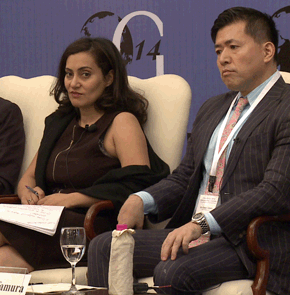
Global Perspectives on Skills Development
• Felix Ortiz, Viridis Learning Inc.
• Sabina Dewan, JustJobs Network
• Tamura Kotaro, Strategic Initiative of Japan
• Nisid Hajari (Moderator), Bloomberg View (Asia)
Changing demographics in the 21st century has led to skills gaps in the new economy. In the global south two issues exist – a large, young, unemployable workforce and a lack of sufficient employment to meet the labour supply. This has created a dire need to find scalable solutions to develop skills while also creating better jobs. In countries like Japan, it’s the aging population who require longer careers and access to new types of employment. Similarly, in the Americas, the new economy is seeing an increased demand for middle skilled and creative employees, making younger generations believe formal college educations are expensive and unsuitable in preparing them for employment. Technology can be a common ground in providing opportunities for these demographic shifts, whether to disseminate skills training virtually to masses in India, to formulate sophisticated algorithms to match potential employees to training courses and jobs, or to create jobs virtually. Mindsets also need to be changed to meet the skills gaps being created globally - skilled workers need to be shown career growth and have opportunities to up-skill through trade schools or other programs that are equally valid in the job market. Finally, public and private collaborations will also be crucial in addressing skills needs, in the provision of actual skills training programs and their accreditation, and also in the creation of new jobs.
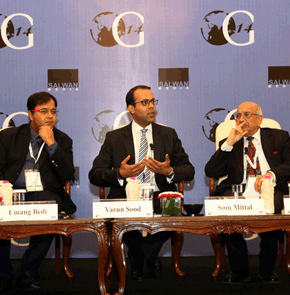
Is Technology an Educational Bridge or Divide in India?
• Suneet Singh Tuli, Datawind Ltd.
• Som Mittal, Former President - NASSCOM
• Umang Bedi, Adobe Systems
• Vinay Kumar, Microsoft
• Varun Sood (Moderator), Fortis
There is no doubt that technology is providing a variety of new educational opportunities that will transform the way children learn in the 21st with digital penetration at only 20% and an education system that is low quality and Century. In India, hard to access, bridging educational gaps through technology will be challenging but possible. Potential in terms of access exists - it takes the government less money to build towers and fibre optic cables for internet connectivity than it does to build roads, and mobile phone penetration is extremely high and could be used innovatively for education programs. Today, the affordability of technology remains an issue, but as price barriers begin to break, India will see mass adoption at an alarming quick rate. However, while access to technology will increase significantly in due time, is only one side of the coin. Technology is just an enabler and it will be the quality of its implementation that assures widespread educational benefits. This can include developing engaging curricula to be used on internet enabled devices, utilizing the internet and multimedia formats to create student-generated content, as well as transforming teacher-student transactions within the classroom where students are focused on self-study and teachers are focused on facilitating learning and curating content.
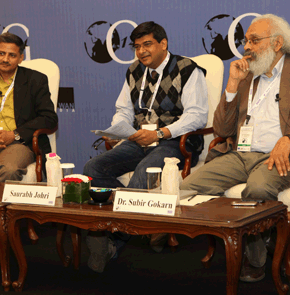
Can we Scale Indian Education with a Focus on Quality?
• Dr. Subir Gokarn, Brookings India
• Shailendra Kumar Sharma, Pratham
• Saurabh Johri (Moderator), Observer Research Foundation
A trade-off often exists in the relationship between scale and quality in any sector – when scale increases, quality tends to suffer. In the education sector, the biggest quality issue today revolves around the face that inputs are not generating outputs. At its lowest level, quality addresses basic metrics, such as if a student can read and write at an age-appropriate level. According to the 2013 ASER report, while India’s access to primary education is significant thanks to education policies like the Sarva Shiksha Abhiyan and Right to Education Act, student assessment outcomes have become poorer. What this suggests is that India is hitting the quality/scale debate at the lowest level – most children cannot read and write at the most basic level. Policies like RTE have been less effective because they were created on the assumption that a 1970’s style education would work today. However, what a quality education requires is school infrastructure, innovative pedagogy and content, improved teaching standards, and technology. The solution lies in creating accountability at the systemic level to overhaul the role of the teacher in the classroom. The government needs to re-establish an education ecosystem that disembodies content and empowers teachers by increasing teacher capabilities, skills and mentoring abilities while also developing their problem solving skills, ability to inspire children and above all, utilize technology and the internet to facilitate curated content.
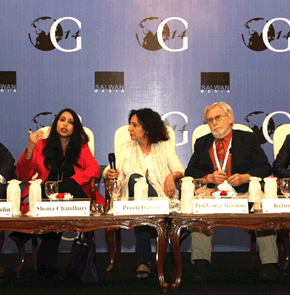
The Role of Media in Education Policy and Culture
• Sunita Kohli, K2India Architects and Designers
• Ketna Patel, Artist
• Prof. George Mclemore, University of Texas
• Shoma Chaudhury, Former Managing Editor – Tehelka
• Chokan Laumulin, University of Cambridge
• Preeti Dawra (Moderator), Insight Asia
Media impacts every layer of our lives, and touches our education systems and culture in various ways. Media in India today is shrill and hollow; it does not provoke in-depth thought or influence discourse because it is not analytical in nature. Instead, media in India is perpetuating flat stereotypes that dehumanizes and demoralizes our psyches and competes with our long-held cultural traditions. In order to challenge this, India requires a resurgence of the liberal arts education that can encourage multi-prong thought and is analytical, intellectual and allows India’s next generation to think more creatively. Only then can media evolve into asking the right questions and actually critically contribute to policy discourse. At the same time, art needs to be brought into schools so younger generations can develop their creativity and critical thinking skills earlier, and can understand how to communicate ideas and break away from stereotypes through their own, independent points of view.
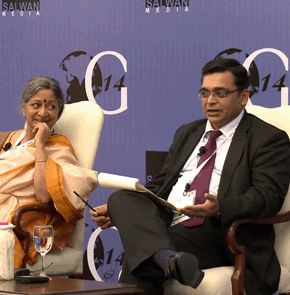
The Role of Storytelling in Schools
• Unmesh Brahme, Room to Read
• Geeta Dharmarajan, Katha
• Lisa Heydlauff (Moderator), Going to School
The best speakers and communicators tell stories – stories garner creativity, imagination, and listening to the voice inside. In India there is a sheer lack of children’s writing being published today, which is detrimental to a child’s development; stories are one of the most powerful sources of receiving and retaining knowledge, particularly for children. Children learn history, cultural awareness, human sensitivity, confidence, national citizenship and most importantly, language, from stories. At the same time, formal education lacks the inspiration required to help children with creativity, and stories can bridge that gap within all socio-economic strata. With the advent of technology, digital story-telling may have potential down the road to transform the oral and written traditions in India. But for now, digital penetration can’t make up for the lack of infrastructure, expertise, localized context and creativity that traditional story telling can and should bring to the Indian classroom.
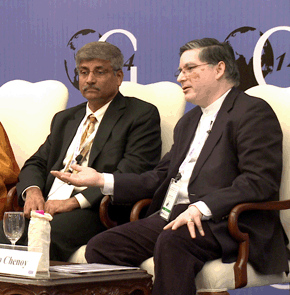
Getting to 500 Million: Challenges and Opportunities in Skills Development in India
• Dilip Chenoy, National Skills Development Corporation
• Dr. Sethuraman Panchanathan, Arizona State University
• Mahendra Bapna, Harvard Advanced Leadership Fellowship
• Rita Soni (Moderator), NASSCOM Foundation
In the past four years, progress towards the national goal of skilling 500 million people by 2020 has been slow, with The National Skills Development Corporation (NSDC) skilling only 3 million youth in this time frame. In order to meet the demand of employing 1 million Indians in formal sector employment every month, players from private training institutions, ITIs, government and the corporate sector will need to collaborate to create an ecosystem for skills development that can be scaled. Skills training first and foremost needs to be aligned with the aspirations of youth, and be positioned as a career opportunity. Credibility and validity must also be extended to vocational training outlets so a confluence between higher education and skilling can exist. Moreover, quality teachers and accreditation are huge concerns, and the private sector can play a vital role in certifying teachers and establishing training standards, especially since they set the skill demands of the economy. Finally, skills development needs to taken into consideration the demands of the future, and provide citizens with the tools to think entrepreneurially, creatively and across disciplines. It’s only when all players come together that shared value can be recognized and scale will be reached in meeting the skilled labour demand of India’s 21st Century economy.
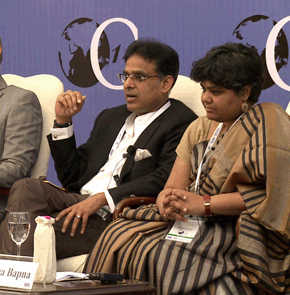
Innovations in K – 12 Education Delivery Models
• Mats Rosén, Kunskapsskolan
• Prabhat Jain, Pathways School
• Akansha Bapna, Evaldesign
• Meeta Sengupta (Moderator), Centre for Civil Society
Innovations in education delivery models can exist within the classroom, within the school system or, in creating praxis to define what education should mean today. It is clear that the Indian education system needs to be overhauled, as can be seen through various assessments and measure of student outcomes. The use of technology, social media and highly crafted content is one way to start changing the way education is delivered within the classroom. At a more universal level however, education also needs to prepare students for the 21st citizens who flourish in diverse environments, who can communicate effectively, think creatively, self-teach skills in a rapidly changing environment, and are well- rounded, excelling in both academic and extra-curricula activities. Personalized learning is also becoming increasingly useful in transforming the educational eco- system, where the equation of education begins with the student and his or her needs. In switching the focus to learning being more child-focused, students are able to better contextualize their education, learn independently and will be better prepared to adapt to the ever-changing needs of the future.





